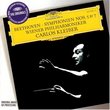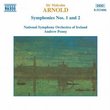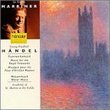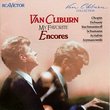| All Artists: Nielsen, Blomstedt, San Francisco Symphony Title: Nielsen: Symphonies 4 & 5 Members Wishing: 0 Total Copies: 1 Label: Polygram Records Release Date: 6/13/1988 Genre: Classical Styles: Historical Periods, Modern, 20th, & 21st Century, Symphonies Number of Discs: 1 SwapaCD Credits: 1 UPC: 028942152427 |
Search - Nielsen, Blomstedt, San Francisco Symphony :: Nielsen: Symphonies 4 & 5
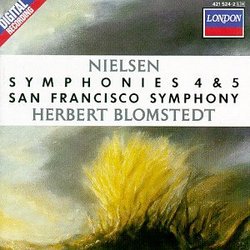 | Nielsen, Blomstedt, San Francisco Symphony Nielsen: Symphonies 4 & 5 Genre: Classical
The composer that Nielsen resembles more than any other as a symphonist is Beethoven. Naturally the idiom is a bit more modern (though firmly tonal and melodic), but there's the same sense of drama, energy, and musical c... more » ![header=[] body=[This CD is available to be requested as disc only.]](/images/attributes/disc.png?v=15401716) ![header=[] body=[This CD is unavailable to be requested with the disc and back insert at this time.]](/images/attributes/greyed_disc_back.png?v=15401716) ![header=[] body=[This CD is unavailable to be requested with the disc and front insert at this time.]](/images/attributes/greyed_disc_front.png?v=15401716) ![header=[] body=[This CD is unavailable to be requested with the disc, front and back inserts at this time.]](/images/attributes/greyed_disc_front_back.png?v=15401716) |
Larger Image |
CD DetailsSynopsis
Amazon.com The composer that Nielsen resembles more than any other as a symphonist is Beethoven. Naturally the idiom is a bit more modern (though firmly tonal and melodic), but there's the same sense of drama, energy, and musical concentration that you find in Beethoven's symphonies. When you listen to Nielsen's music, you can't miss the sense of purpose--the music has a goal and will literally overcome any hurdle to get there. That's exactly what happens in these two splendid symphonies. Herbert Blomstedt has been a forceful proponent of Nielsen's music for his entire career, and he plays with total commitment. -- David Hurwitz Similar CDs
Similarly Requested CDs |
CD ReviewsMagnificent but not exactly easy listening chefdevergue | Spokane, WA United States | 10/08/2003 (5 out of 5 stars) "Carl Nielsen really cannot be lumped into any category; he is what he is, and the listener must take him on his terms, which is sometimes easier said than done. His symphonies are challenging to listen to; I usually listen to them on headphones so that I can fully appreciate the full complexity of his harmonies and thematic development.The 5th symphony is particularly challenging. Sometimes it can be just plain weird...it is almost always unsettling. Set in two movements, it seems always to be dealing with a threatening unknown, just looming over the horizon. In the first movement, this manifests itself with a creepy military drumbeat which comes & goes throughout the movement. Instability permeates the movement...it finally ends on a calm but hardly settling note. The second movement is still settled although not as creepy. There is a slower interlude --- calm but anguished at points --- which leads to one last burst of manic energy before ending grandly on an E flat major chord, which really seems to come out of nowhere. Even the triumphant conclusion contributes to overall unsettling nature of the work.The 4th Symphony, "The Inextinguishable," typcially displays Nielsen's tendency of hovering around a tonal base, but never quite giving the listener that which he yearns for. The symphony is struggling towards a final triumphant conclusion, and finally achieves it, but not before a rough musical road has been travelled.Blomstedt has deservedly received acclaim for his Nielsen cycle, and his talents with Nielsen's music are in abundant evidence here. This CD is definitely recommended, but may not be for the musical novice. An experienced ear is needed to appreciate the full complexity of the music." Essential Nielsen symphonies Robert E. Nylund | Ft. Wayne, Indiana United States | 11/20/2003 (5 out of 5 stars) "When Herbert Blomstedt first became music director of the San Francisco Symphony in the fall of 1985, there was little doubt that the orchestra would finally play the symphonies of Carl Nielsen. I had first discovered Nielsen's music through Vanguard imports of recordings by Sir John Barbirolli and the Halle Orchestra, recorded in the mid 1960's. From listening to those milestone recordings, it was immediately clear that Nielsen, who lived from 1865 to 1931, was highly original and imaginative.Among the first Nielsen symphonies I heard was the fourth, which he subtitled "Inextinguishable." The recording almost sounded as if was had joined the music in progress. Perhaps Nielsen intended to convery that the music HAD been going on for some time. The symphony certainly doesn't stop, once it begins.As much as I enjoyed Barbirolli's wonderful recording (originally issued in England on the Pye label), Blomstedt's 1987 performance with the San Francisco Symphony is even better. It is absolutely unbelievable in its intensity, even when we come to the intriguing second movement. After some absolute bombast and turbulence, with brass scorings that reminded me of Anton Bruckner, the music subsides to something quiet, light, and rather humorous. It is not as satirical or sarcastic as Nielsen's last symphony (the sixth), but the second movement is definitely a great contrast to the tragic intensity of the other movements.Blomstedt succeeds in getting the San Francisco musicians to play with their hearts and clearly shows that things have changed the occasional inconsistency that emerged under Jorda, Krips, Ozawa, and DeWaart. The orchestra had actually steadily improved once Josef Krips took over in 1963, after a terrible decline during Enrique Jorda's tenure (1954 to 1963). Yet there were problems even after that, particularly with sloppy playing by the brass; none of that is the case in the Nielsen symphonies recorded here.Blomstedt was born in the U.S. to Danish parents and spent most of his life in Europe before coming to San Francisco. Not surprisingly, he developed a great love for the music of Carl Nielsen, who was born the same year as the Finnish master Jean Sibelius but went in a much different musical direction.Nielsen's fifth symphony is almost agonizing at times. It uses a snare drum and other percussion to create a musical impression of an advancing army. Was Nielsen reacting to the events of World War I? Typically, Nielsen would have resisted calling this a "war" symphony, but it definitely belongs to a turbulent period of European history. The program notes say that Nielsen led a "quiet" life, but he clearly expressed himself in his music and this is one of his most powerful musical expressions. The San Francisco orchestra plays with great passion and precision at the same time.The fourth and fifth symphonies were the first works the San Francisco Symphony recorded for London/Decca, after making a number of recordings for Deutsche Grammophon and Phillips under Seiji Ozawa and Edo DeWaart. The recording was the beginning of a very fine association with the British recording company." From Robert Layton's Review in Gramophone Record Collector | Mons, Belgium | 04/19/2006 (5 out of 5 stars) "Blomstedt recorded Nielsen's complete orchestral works with the Danish Radio orchestra in the mid 1970s on an eight-LP set for EMI, so he is no stranger to this repertoire. But his later records of Strauss's Ein Heldenleben and Bruckner's Fourth and Seventh with the Staatskapelle, Dresden (all on Denon) show him to have grown in depth and stature. I can recall his debut in Stockholm in the mid-1950s when he conducted. a very well prepared if rather cool account of Hindemith's Mathis Symphony.
Blomstedt's new opening has splendid fire: this must sound as if galaxies are forming, in tempo and character it is close to the inspiring 1952 Jensen broadcast on a Danacord LP and to Grondahl's LP. Generally speaking Blomstedt is less circumspect than he was in his earlier set and less frightened of letting things rip. You may remember the composer's oft-quoted simile concerning the soaring string lines in the slow movement ('like the eagle riding on the wind'). Simon Rattle (EMI) is tremendously intense, almost pesante here, and does not follow the change of metronome marking between the opening (crotchet= 52-56) and at fig. 32 (crotchet=68) to such striking effect. Blomstedt conveys Nielsen's image most strikingly and there is much in this movement that is sensitive and atmospheric. The finale is exhilarating yet held on a firm rein. Blomstedt's Fifth Symphony, too, is impressive: it starts perfectly and is almost as icy in atmosphere as Jensen (Decca LP) or Tuxen (EMI LP), and the climax is well handled. The desolate clarinet peroration comes offmost successfully too. He brings one closer to the music than he did in his 1975 recording and I prefer his finale to Chung (both the fugal episodes come off better) and to Salonen who broadens the closing bars to the point of bombast (forgivable youthful impetuosity no doubt but tiresome on repetition). Nielsen's Fifth is probably better than it can be played but this new account is certainly among the finest now on the market. Ole Schmidt's performances (Unicorn-Kanchana) of both symphonies still strike me as having something special to say even if neither the orchestral playing nor the recording is the equal of the newcomer. Blomstedt's recording balance could not be improved upon: the woodwind are decently recessed (though clarinet keys are audible at times) and there is an almost ideal relationship between the various orchestra sections as well as a thoroughly realistic overall perspective. He obviously has a good rapport with the orchestra, who sound in excellent shape and respond to these scores as to the manner born. I hope he is introducing his fellow musicians to the Stenhammar and Berwald symphonies and that he will persuade Decca to give us a new version of Hilding Rosenberg's Third and better still what would be a premiere recording of Hortulanus, his Fifth (and to my mind greatest) symphony. " |

 Track Listings (10) - Disc #1
Track Listings (10) - Disc #1
